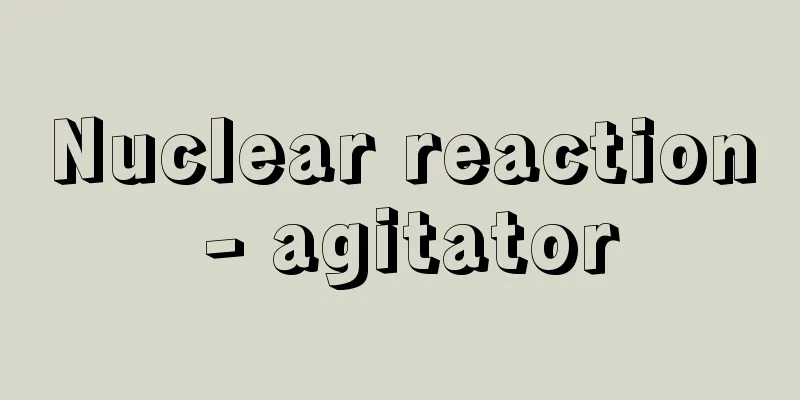Nuclear reaction - agitator

|
A process in which a particle is incident on a nucleus, producing another nucleus and releasing one or more particles. It is also called a nuclear reaction. The incident or released particle includes gamma rays. If the target nucleus is X, the incident particle is a, the nucleus produced by the nuclear reaction is Y, and the released particles are b, c, ..., the nuclear reaction is written as X + a → Y + b + c ... or X (a, bc ...) Y. If the incident particle is a proton, it is called a p reaction, if it is a neutron, it is called an n reaction, if it is an alpha particle, it is called an alpha reaction, if it is a deuteron, it is called a d reaction, and if it is a gamma ray, it is called a photonuclear reaction. When a heavier nucleus is incident, it is called a heavy ion reaction. The process X + a → X + a is called elastic scattering, and in this case it is not included in the nuclear reaction. However, if X is in an excited state X' after the reaction, it is called inelastic scattering and is considered a type of nuclear reaction. An X(n,p)Y type reaction is called an (n,p) reaction, and an X(p,α)Y type reaction is called a (p,α) reaction. The rate at which a nuclear reaction occurs is expressed as the number of particles that react when a particle is incident on a target nucleus at a rate of one per second per cm2 , and this is called the reaction cross section. In the early days, the incident particle beam was alpha rays from natural radioactive materials, but since then, various particle beams have been obtained from accelerators. Gamma rays are obtained by bremsstrahlung from high-speed electrons obtained in betatrons and electron synchrotrons. Neutrons are obtained from an appropriate neutron source. The conserved quantities in a nuclear reaction are energy, momentum, angular momentum, mass number, and charge. There are two types of reaction mechanisms: those that pass through a compound nucleus and direct reactions. The cross section of a reaction that passes through a compound nucleus can be described in terms of potential scattering and resonant scattering. The evaporation theory can be applied to the emitted particles. An example of a direct reaction is the stripping reaction of a deuteron. As the energy of the incident particle increases, the target nucleus releases many particles, causing nuclear fragmentation. As the energy increases further, π mesons are also produced. Nuclear species produced in nuclear reactions can be stable or radioactive. Neutron capture X(n,γ)Y often produces radioactive nuclides. E. Rutherford (1919) was the first to successfully perform a nuclear reaction, using alpha rays from natural radioactive elements to produce the reaction 14N +α→ 17O +p. An artificial beam was obtained in 1932 by J. Cockcroft and E. Walton, who injected 0.6MeV protons into the nucleus of lithium 7, causing the reaction 7Li +p→ 4He + 4He . This nuclear reaction produced a new kinetic energy of 17.3MeV, verifying the equivalence of mass and energy. Source: Encyclopaedia Britannica Concise Encyclopedia About Encyclopaedia Britannica Concise Encyclopedia Information |
|
ある原子核に粒子が入射して,他の原子核を生じ,1個以上の粒子が放出される過程。原子核反応ともいう。入射粒子または放出粒子には γ 線も含む。標的原子核をX,入射粒子をa ,核反応で生じる原子核をY,放出される粒子をb,c,…とすると,この核反応はX + a → Y + b + c …またはX (a,bc…) Yと書かれる。入射粒子が陽子ならばp 反応,中性子ならばn 反応,α粒子ならばα反応,重陽子ならばd反応,γ線ならば光核反応などという。またもっと重い原子核が入射するときを重イオン反応という。X + a → X + a の過程を弾性散乱といい,この場合は核反応に含めない。しかし,反応後Xが励起状態X ' である場合は非弾性散乱といい,核反応の一種とみなす。またX (n,p) Y型の反応を (n,p) 反応,X(p ,α)Y型の反応を(p ,α) 反応などという。核反応の起る割合は,標的核に対して 1cm2あたり毎秒1個の割合で粒子を入射させたときに反応を起した粒子の個数で表わし,これを反応断面積という。入射粒子のビームは初期には天然の放射性物質からのα線であったが,以後は種々の粒子ビームが加速器で得られている。またγ線はベータトロンや電子シンクロトロンで得た高速電子の制動放射により得られる。中性子は適当な中性子源から得られる。核反応の際の保存量はエネルギー,運動量,角運動量,質量数,電荷である。反応機構には,複合核を経由するものと直接反応とがある。複合核を経由する反応の断面積はポテンシャル散乱と共鳴散乱とで記述できる。また放出粒子については蒸発理論が適用しうる。直接反応の例は重陽子のストリッピング反応である。入射粒子のエネルギーが高くなると標的核は多数の粒子を放出し,核破砕が起る。さらにエネルギーが上がると,π中間子の発生も起る。核反応で生成された核種は安定なものと放射性のものとがある。中性子捕獲 X (n,γ) Yではしばしば放射性核種を生じる。核反応の実験に成功したのは E.ラザフォードで (1919) ,天然の放射性元素から得られるα線を使って 14N+α→17O+p の反応を起した。人工のビームは 1932年 J.コッククロフトと E.ウォルトンによって得られ,0.6MeV の陽子をリチウム 7 の原子核に入射させて,7Li+p→4He+4He の反応を起した。この核反応では新たに 17.3MeV の運動エネルギーを生じ,質量とエネルギーの等価性の検証となった。
出典 ブリタニカ国際大百科事典 小項目事典ブリタニカ国際大百科事典 小項目事典について 情報 |
Recommend
Bed - Show
[Sound] Shou (Shau) (Idiomatic) [Reading] A comfor...
Neptune whelk
This snail belongs to the family Bucconidae of th...
Grimmia elongata (English name) Grimmia elongata
...In Lake Kussharo in Hokkaido, the moss Drepano...
claw
…In mammals, claws are specialized according to f...
Network-forming oxides
… Glass is made up of various oxides, and they ar...
Plane - Plane
A type of woodworking machine used to finish sawe...
Brama japonica (English spelling)
...A marine fish of the family Pongoidae in the o...
International New Education Fellowship
…In 1898, French educational reformer JE Demolins...
Proportional counter
A type of device that measures the energy loss of ...
Osamu Ishihara
A medical scientist. Born in Hyogo Prefecture on ...
Viriato (English spelling)
? - 139 BCE A Lusitanian chieftain who resisted th...
jester
…The word fool originates from the Latin follis (...
Cornelius Nepos
An ancient Roman biographer. His main work is the...
pilum
...Weapons are often associated with metal, but v...
Dana
In Celtic mythology she is the great earth goddess...









